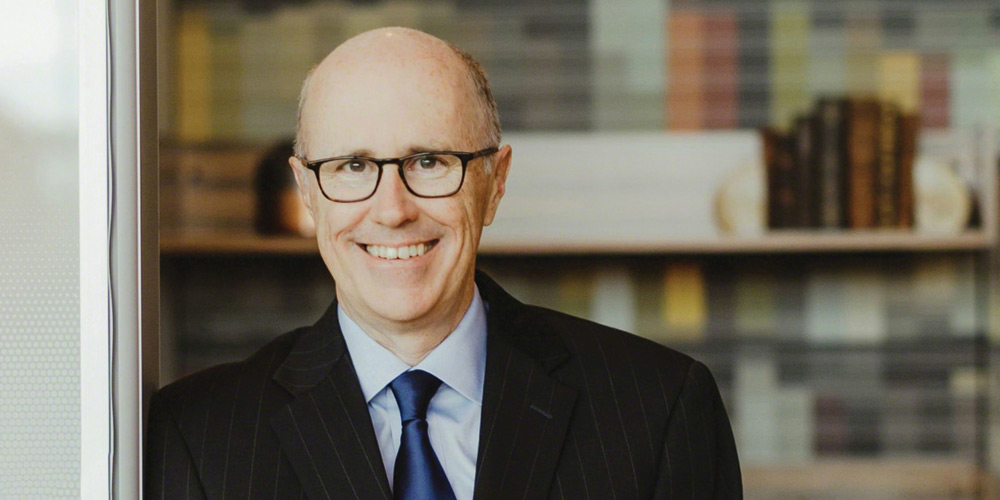Creating a culture of learning
Steelcase CEO Jim Keane explains how giving people work-space choices can make workplace behavior more human.
This interview is part of the Inside the Mind of the CxO series, which explores a wide range of critical decisions faced by chief executives around the world.
Organizations have two kinds of architectural design: the layout of office space and the design of relationships and culture. Both have been preoccupations of Steelcase since 1912, the year it was founded. The company’s name reflects its original products: metal safes, filing cabinets, and trash cans designed to be fireproof. It is now the largest office furniture manufacturer in the world: a US$3.4 billion company whose business increasingly depends on its customers’ ability to use workplace design in a way that improves the productivity and creativity of their employees.
Jim Keane was appointed president and chief executive officer of Steelcase in March 2014; he is the ninth person to lead the century-old company. The first of his family to go to college, he has been a leading voice among chief executives for the humanization of the business experience. In combination with the research that Steelcase has conducted over the years on workplace quality of life, this emphasis gives him a distinctive perspective on enterprise technology: It is valuable to the extent that it helps people (and thus organizations) develop their potential.
Under Keane’s leadership, Steelcase has positioned itself as an innovator in flexible space and human-oriented workplace design, as well as in participative management. Its own experiments, which include the glass conference rooms and retreat-style offices described in this interview, along with ergonomic chairs and customizable-on-the-fly office furniture, are all influenced by the company’s broader philosophy.
This philosophy also affects its acquisitions and other ventures. In September 2018, for example, Steelcase purchased Orangebox, a company founded in Wales in 2004 that was known for its reconfigurable, modular “pod” work spaces and meeting rooms. Steelcase also has an ongoing partnership with Microsoft to design “seamless” work spaces in which the space and display technologies are integrated to spark creativity and better workflow.
Jim Keane sat down with strategy+business at Steelcase headquarters in Grand Rapids, Mich., in May 2019. We met in a glass-walled conference room in the company’s learning center — which is also where the Steelcase executive team works — and began by discussing the effect of technology on jobs, a topic he frequently addresses.
S+B: You have said that many of the jobs that are disappearing through automation are not worth keeping. Why do you believe that?
KEANE: The prevailing conversation about artificial intelligence (AI) largely goes down a couple of paths. First: AI is going to eliminate all of our jobs, and what will we do? Second is the science fiction version: AI will eliminate any need for people at all. Yet, when I look back at how technology has evolved and the effect it’s had on work, my conclusion is very different. Yes, it’s eliminated some jobs, but which of those jobs would we actually want back? Very few.
When I started my career, executives were not expected to know how to type. Assistants typed up what the executives wrote out by hand. Then personal computers appeared, and executives began to write using a keyboard. You could say that eliminated some jobs, but that statement doesn’t capture the other things that happened. The technology made it possible for executives to iterate their thoughts. The quality of what we generated was much better than it was when we had to apologize to an assistant for making them retype a letter.
With robotics and AI, something similar will happen. Yes, some jobs will be eliminated. But the technology will make it possible for people to be more effective and more productive, to use a broader range of skills, and to learn. I don’t see that as a bad thing.
S+B: Not every job holder would agree.
KEANE: The challenge is different than simply preserving jobs. When I was starting out, I worked as an elevator operator. I can assure you, we really don’t want those jobs back. But even the most menial and basic jobs, with simple, repeatable work, can be framed in a way that treats people as people, and not as machines. In the elevator, I was officially not allowed to talk to passengers. But I started making jokes. I discovered I could tell the same joke over and over because nobody had heard it before. But when they got to their floors, they would talk about it; they had all heard it from the guy in the elevator. I found a way to reframe that job to use a bit more of my humanity.
Even now, how often do companies limit the range of ways people can do their work? And can we challenge ourselves as managers to do better?
S+B: What kinds of things are you thinking of?
KEANE: Here is a real-life example. Most call center jobs have very high turnover. After a few months on the job, employees learn that the script isn’t meeting the needs of the people they talk to. Nonetheless, they’re forced to go through the script the same exact way each time. In fact, they’re being recorded, so that if they deviate, they’ll be disciplined. Any of us would feel like quitting. “I’m not learning. I’m not making progress. I don’t feel any connection.”
You can’t get rid of call centers. But instead of forcing people to stick to a rigid script, you could allow them to use their own problem-solving ability, creativity, and imagination. I recently heard a CEO describe how they did that exact thing with their call centers. They saw turnover fall and customer satisfaction rise dramatically. All it took was letting go of the idea that the top executives know more about what customers might want than the person who happens to be on the phone.
Releasing control involves trust — trusting that people will make good choices if you give them a chance. Employees feel much more of a connection to the company and its mission when they feel like they’re getting better the longer they work there. Customers feel it, too.
The nonlinear chief executive
S+B: Business leaders have heard this message many times before without putting it into practice. Do you think they’re more receptive now?
KEANE: When I was starting my business career, books like Reengineering the Corporation [by Michael Hammer and James Champy, published in 1993] were popular. The business world was trying to gain efficiency and reliability by creating formulas, rigid scripts, and repeatable processes. So we hired diverse people, and then trained them to act identical, to follow the same script.
But the world’s more competitive now. Everyone can deliver predictable, reliable, mediocre experiences. To compete today, you have to solve problems in unexpected ways, in remarkable ways. You still hire diverse people, but you must celebrate their diversity: Tap into it, leverage it, and share those different ways of working. It’s no longer the script that makes an organization competitive. It’s how the workforce evolves over time, to continually generate better and cleverer ideas and put them to use.
Automation is eliminating a lot of the work that had to be uniform. Rather than teaching people to operate with the efficiency of a computer, have a computer do that part. Let humans focus on the creative, differentiated, more productive work that [they] are particularly good at.
S+B: How does this new reality affect the role of the CEO?
KEANE: Many managers still rise in organizations because they are good at process optimization, driving out waste and inefficiency, and managing for scale. But when you become CEO, your priorities change. You discover more complex issues that can’t be solved through process optimization. Suddenly you spend your time thinking about why the things that ought to be getting better aren’t getting better, and why they may be getting worse.
For example, many CEOs are trying to improve diversity in their organizations, and to create less hostile environments. Yet no matter how hard they try to shift the rules — “Let’s set targets, hold people accountable, and engineer our way toward a more diverse workforce” — they’re not succeeding. Workplace behaviors still sometimes get toxic, even though nobody wants them to.
To understand why this happens, you have to think in less linear ways. For example, instead of trying to lock everyone into one diversity-and-inclusion process, what if you let employees choose their approach, and talked about that choice openly? You need to develop a culture of learning if you want to be innovative.
S+B: What can you do to help leaders understand workplace behaviors? You’re asking a lot of the organization, its leaders, and its employees.
KEANE: Yes, and we’ve seen this firsthand ourselves. Our company’s leaders use the learning center as their home base, and they have spaces here for focused work. But the open layout means they’re also visible and accessible. In moving to this design, we gave up some of what used to be considered productivity. People ask, “Don’t you get distracted? Don’t you get interrupted? Don’t you lose efficiency when you’re in a space this active?” The answer is yes.
But this layout also gives us insight into what’s happening in the organization. Earlier this week, I met our new interns because they were walking through here. Today, I met a customer group because they happened to be walking through this space. There are many things that I would not have known about, that I learned just by having the flow of people through this space.
S+B: How do you deal with the need for privacy?
KEANE: We do have private offices, but they, too, are based on a different concept of workplace effectiveness. My current office, which is still in prototype form, is only three feet wide by six feet long. It’s too small to meet with others in, and I don’t invite people to meet me there. My office is a place I go to in between meetings, to practice something we believe in here: that to sustain energy and avoid burnout, people can’t jump from one meeting to another. By the fifth meeting in a row, if you go back-to-back into them without time to prepare or recover, you’re really not good anymore. You’re exhausted, or still angry about what happened at the third meeting. But these people at the door for your 4:00 meeting have been waiting a month to see you.
So we encourage a practice of setting time aside: preparing for every meeting, performing during the meeting, and recovering afterward. Recovery can be very short, but it allows you to re-center yourself so you can be present in the next moment.
S+B: Is that insight about meeting management original to Steelcase?
KEANE: Yes. It came about in part through our research on how to sustain high performance. More generally, we have found that the design of the work space can shape behavior, whether you chose that behavior or not.
For example, because my office is not for meeting people, that makes it easier to manage meetings productively. After I’m done talking with you today, I will leave this conference room and return to my small private room. I will close the door for a few minutes. I will finish up any follow-ups to our conversation, think about what’s next, and be ready to fully engage in that next meeting.
Learning is an obligation
S+B: What else, besides office design, is involved in enabling this kind of behavior shift?
KEANE: First, you have to create a culture of learning. Investing in people, and helping them continually develop their skills, should be embedded in a company’s culture. That doesn’t just mean training people in what the company decides is important to them. At least a portion of the learning agenda should be based on what the individual chooses to learn about. The role of the company is to continually challenge and develop its people, starting at the top. In fact, I think the company has an obligation to do so.
S+B: Why do you call it an obligation rather than an opportunity or a choice?
KEANE: Our customers realize that they’re people-constrained. When they think about office design, they frame it around attracting new people, winning the war for talent. But the real battle is engaging the thousands of people who work for you right now.
If I’m a shareholder of a company, I want to hear more about that. It’s not clear that you can attract more people than your competitor, because that’s a zero-sum game. Many countries are at full employment. But you can improve the performance and productivity and growth of the people who already work for you. To sustain a continual rise in shareholder value, you need to do more than just improve productivity by 10 percent once or twice. You need to invest in the continuous improvement of your people.
S+B: How does this affect the innovation of new products and services?
KEANE: Innovation starts with failure. It starts with a crazy idea, a prototype that doesn’t work. Process-oriented cultures usually don’t like to talk about failure. “There’s an acceptable parts per million of error; we don’t want too many of those.”
To sustain a continual rise in shareholder value, you need to do more than just improve productivity by 10 percent once or twice. You need to invest in the continuous improvement of your people.”
But in a culture of learning, people are curious about what they can learn from their failures. They try to fail more quickly, in new and more interesting ways each time. The key to innovating at scale is to have as many of those learning cycles as you possibly can, as quickly as you can. The things that don’t work tend to lead to other ideas.
This is not the Steve Jobs model, in which the CEO is the brilliant sole creator of new ideas. In a more sustainable, scalable model, the role of the CEO is to create a thousand Steve Jobs inside their own company, innovating every day. Yes, we’re asking a lot of the company. We’re saying, “First, don’t forget about what made you great. Second, be efficient from a process perspective. Third, take on the new challenge: Figure out how to innovate at scale.”
S+B: Can you really get enough people at scale to develop the judgment and acumen they need to innovate in powerful ways, with powerful results?
KEANE: You have to create an appetite for learning in the company, and learning starts with vulnerability. In our innovation training classes, people have to stand up before their peers and present their new product as if to a client. They typically deliver a not-very-good presentation, get feedback, listen to their peers’ presentations, and improve. These classes help build a culture where vulnerability and failure are seen as beneficial.
The glass walls of this conference room are lined with a polarized film we developed, called Casper. Passersby can see who is meeting in the room, but they can’t see the LCD screen displays — so the discussions remain private. A Steelcase employee created that film as his own innovation project. We didn’t know what the application was going to be when he started working on it. Then we moved into this space with all these large windows. The prototype film was only two feet wide, so we challenged him to make a wider sheet. He found a manufacturer, and we put [the film] up in this room, right in front of employees, customers, and everyone else walking by.
It was awful. It worked, but it had a kind of rainbow discoloration. As you looked at it from different angles, you’d see these weird patterns, like an oil slick. Some people in the company said we shouldn’t leave it up, because customers would come by and see that it wasn’t very good. But we decided instead to tell them that we were still experimenting. In our culture, you can innovate out in the open.
A few weeks later, the same employee presented us with a new version that wasn’t discolored. But it had little bubbles in it. There was a problem with the film’s thickness, and no matter how hard we tried, when we applied it to the glass, we couldn’t get the bubbles out. We kept iterating, leaving each version up until we had the next one, until we had a viable prototype. That’s an example of bringing failure out into the open. You show it to people while you’re creating it, and you tell the story in an honest, authentic way.
My private office, which is on this same floor nearby, is another prototype. Its design is not directed by me, but by a team of people in charge of this group of innovations. I don’t often know in advance when it’s going to change. As CEO, I don’t have to submit myself to working in a prototype space. But I do, because starting at the top of the company, we all have to send the message that this is how innovation happens. We all have to be willing to experiment, be vulnerable, take risks, and live with failures as we work toward something better. None of us were taught this. It isn’t in any guidance from the old days.
The evolution of office space
S+B: What are the significant trends in office design that are going to affect workplace behavior in the future?
KEANE: There’s a direct line from changes in business processes and technology to the way office space evolves. In the 1940s and 1950s, organizations were smaller and hierarchical. One senior person made all the decisions. The purpose of office design was to protect that person’s productivity. The president had a corner office; the VPs all had offices the same size. Then, in the 1960s, with more open communication, many companies moved to a bullpen with individual desks in a large room, set up a prescribed distance from one another. In the ’70s and ’80s, as computer terminals came along, we had a lot of data entry. Cubicles became popular because those big, square CRT screens had to go into corners. And there weren’t ERP systems, so people printed out data from one system to enter into another. We built overhead binder bins and file cabinets. With HR departments setting up hierarchies, the size of the workstation directly related to the pay grade. “Why don’t I get a guest chair?” “Because you’re grade 7; when you’re grade 8 like Katie over there, you’ll get a guest chair.” You could tell how much money people were making by their office furniture.
S+B: And many offices are still like that.
KEANE: Exactly right. The work kept changing, and processes kept changing, and the technology changed from CRT to laptop and from cable to Wi-Fi. But that cubicle style was so locked in, and so closely tied to pay grades, that it was hard to evolve away from. When they lost their cubicles, people felt like something was being taken away from them. So they put their laptop in the corner of their workstation, where the CRT used to be.
S+B: And that’s why people don’t like open plan offices?
KEANE: In my opinion, the problem isn’t open or closed offices. The problem is uniformity. In a world of process optimization, the first battle is to make everything uniform. You may hire diverse people, but you want them to conduct their work the same way. You make the furniture, the technology, the software, the process, and the training the same.
Today’s open plan offices still suffer from that assumption that one size must fit all. We’ve simply moved from “everyone gets a private office,” to “everyone gets a cubicle,” to “everyone gets a seat at the bench,” to “everyone shares the bench.” The problem isn’t any of those ideas. It’s the idea that everyone gets exactly the same thing. The solution is to put freedom back in the mix. So what if I gave you a choice? What if at 10:00 this morning, you feel like sitting over by the window? Or going into a small space where you could close the door? Or you like working outside? Whatever it is that works for you in that moment, why not give you the choice? And it shouldn’t tie to your pay grade or your job description. It shouldn’t tie to anything but what’s right for you, and you get to be the expert on what’s right for you.
This is the modern view of a workplace: to create a much broader range of settings than before, and give people more choice about how they’re going to work in any particular moment. People spend eight to 10 hours a day working. We can make a difference by taking them away from outdated or dehumanizing environments.
S+B: How does this affect what a company like Steelcase sells?
KEANE: For any given project, we will sell fewer units of any particular product, and a much wider range of products. We’ll design work spaces where people work individually and have more privacy, and spaces where people work collaboratively. Work-space planning is no longer a matter of picking out chairs and desks; it now encompasses a wide range of activities.
Planning also doesn’t end on moving day. A few months later, you can assess how people actually use the designs. You can then make tweaks. Maybe rearrange a particular space to coax out more productivity, or take some pressures off another area. The idea of managing space becomes more evolutionary.
We use technology to help. There are now sensors that can gather information about how space is used: which rooms are occupied more or less, which days of the week or hours of the day, and with more or fewer people. All of that information gives you an opportunity to improve your space utilization.
The space affects behavior, which then changes the way we conceive of the space. We originally thought this learning center would be a place for training. People started to use it for other purposes. We followed the pattern that we saw emerging. About 50 percent of our people still have assigned desks. We don’t keep track. If they want one, they can get one. It’s not a coveted asset that people hold on to.
S+B: How do you know this approach to management is working?
KEANE: I can walk up to people here in this office and say, “Hi — why are you working in this spot today?” Fifteen years ago, if you asked that question, they would say, “This is where I sit. I work here because I was told to.”
Now they will tell you a story along the lines of, “I thought it would be great to sit by the window,” or “I was going to work with a friend, and this is a good spot for it.” The point is that they’re engaged in decisions about how and where they work. They’re thinking about it actively.
After a while, that type of choice becomes automatic. People realize that they are not being watched, that they are responsible for generating outcomes, and that their company trusts them — not just for their particular job, but for their good decisions generally. It’s so far beyond the days of the elevator operator.





